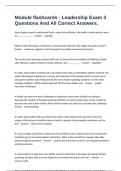Assignment 2 2024
Unique Number: 575513
Due Date: 5 July 2024
QUESTION 1
1.1. (2 ANSWERS PROVIDED)
A home language teacher in a multicultural context should keep in mind several important
aspects when teaching intermediate phase (IP) learners. Firstly, it is crucial to recognize the
value of diversity and understand that each learner comes from a unique cultural and social
background. Teachers should be informed about their learners’ backgrounds, value systems,
and experiences, as these factors influence their dispositions, perceptions, and behavior in the
classroom. This knowledge will enable teachers to design learning experiences that
accommodate and respect their students' different backgrounds.
DISCLAIMER & TERMS OF USE
1. Educational Aid: These study notes are designed to serve as educational aids and should not be considered as a
substitute for individual research, critical thinking, or professional guidance. Students are encouraged to
conduct their own extensive research and consult with their instructors or academic advisors for specific
assignment requirements.
2. Personal Responsibility: While every effort has been made to ensure the accuracy and reliability of the
information provided in these study notes, the seller cannot guarantee the completeness or correctness of all
the content. It is the responsibility of the buyer to verify the accuracy of the information and use their own
judgment when applying it to their assignments.
3. Academic Integrity: It is crucial for students to uphold academic integrity and adhere to their institution's
policies and guidelines regarding plagiarism, citation, and referencing. These study notes should be used as a
tool for learning and inspiration, but any direct reproduction of the content without proper acknowledgment and
citation may constitute academic misconduct.
4. Limited Liability: The seller of these study notes shall not be held liable for any direct or indirect damages,
losses, or consequences arising from the use of the notes. This includes, but is not limited to, poor grades,
academic penalties, or any other negative outcomes resulting from the application or misuse of the information
provided.
]
, For additional support +27 81 278 3372
QUESTION 1
1.1. (2 ANSWERS PROVIDED)
In the multicultural and multilingual context of South Africa, teaching a home language to
Intermediate Phase (IP) learners requires a multifaceted approach that acknowledges and
celebrates cultural diversity while fostering linguistic competence. Here are some crucial aspects
that educators should keep in mind:
1. Acknowledgement of Cultural Diversity
Understanding that learners come from various cultural backgrounds is fundamental. Each
learner carries unique cultural and linguistic experiences that shape their learning disposition.
Recognizing this diversity is critical for creating an inclusive learning environment. Teachers
must show respect and appreciation for different cultures and languages. By doing so, they
validate each learner's identity and self-worth, which can have profound effects on their
engagement and motivation.
2. Contextual Understanding of Learners' Backgrounds
Teachers must familiarize themselves with the cultural and linguistic backgrounds of their
learners. This includes knowing the languages spoken at home, the social circumstances, and
the cultural practices that influence their daily lives. For instance, in the scenario of Lindiwe and
Ndileka, a misunderstanding of their backgrounds led to conflicts and misjudgments by the
teacher, Mr. Nkumane.
3. Cultural Responsiveness in Teaching Practices
Culturally responsive teaching involves using cultural knowledge, prior experiences, and
performance styles of diverse learners to make learning more appropriate and effective.
Teachers should integrate cultural content into the curriculum and use examples that are
relevant to their learners' lives. This approach not only aids comprehension but also helps
learners feel a sense of belonging and relevance in their learning environment.
, For additional support +27 81 278 3372
4. Development of Home Language Proficiency
A solid foundation in the home language is essential for cognitive development and for the
acquisition of additional languages. Teachers should encourage the use of the home language
in educational settings to strengthen linguistic abilities. This involves acknowledging code-
switching as a natural and positive phenomenon in multilingual contexts.
5. Promotion of Intercultural Competence
Communicative competence goes beyond language proficiency; it includes being able to interact
effectively and appropriately with people from different cultural backgrounds. Educators should
teach learners about other cultures present in the community and highlight the intercultural
dimensions of the home language. This can be achieved through collaborative learning activities
that encourage cultural exchange and mutual respect among learners.
6. Adaptation of Instructional Strategies
Different cultural groups may have different learning styles and communication preferences.
Teachers should be flexible and adaptive in their instructional strategies to accommodate these
differences. For example, some cultures may encourage critical questioning and interaction,
while others might promote a more reserved and respectful approach to authority figures.
Recognizing and adapting to these variations can help optimize learning outcomes.
7. Creation of an Inclusive Classroom Environment
An inclusive classroom environment is one where all learners feel valued and accepted,
regardless of their cultural or linguistic background. Teachers should strive to build a classroom
community that celebrates diversity and promotes equity. This includes addressing any form of
linguistic racism or stigmatization and ensuring that learners have positive perceptions of their
home languages.
8. Integration of Learner-Centered Approaches
Employing learner-centered approaches that cater to individual learner needs and preferences
can significantly enhance engagement and learning. This might involve using differentiated










